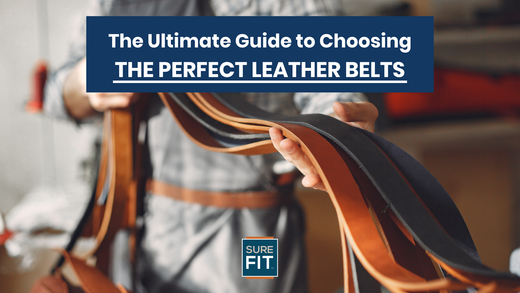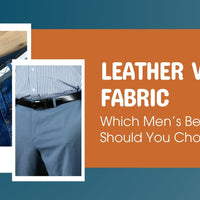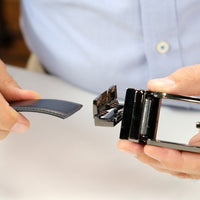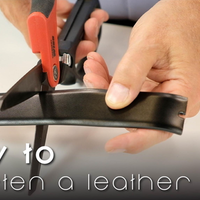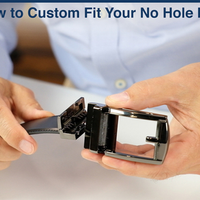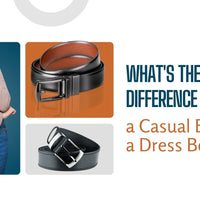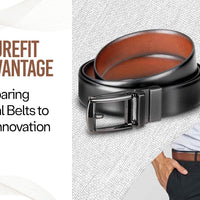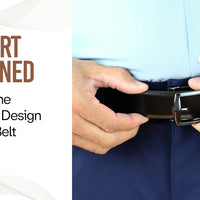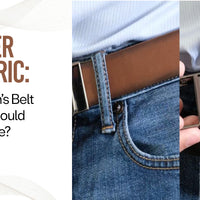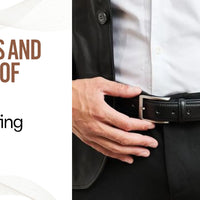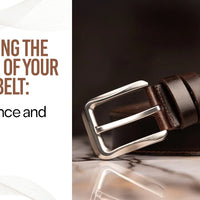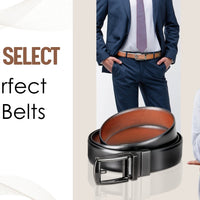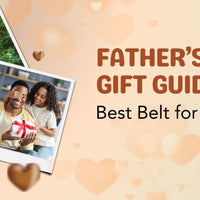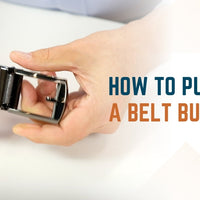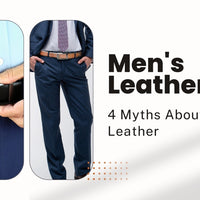A leather belt is not just a functional accessory; it’s a statement of style and craftsmanship that can bring any outfit with its style. Whether you’re dressing up for a formal occasion or aiming for a casual look, understanding the nuances of leather belts—types, styles, and quality—is essential for making a confident choice. Here’s your comprehensive guide to navigating the world of leather belts:
Types of Leather
Choosing the right type of leather for your belt is crucial as it determines its durability, appearance, and how it ages over time.
- Full-Grain Leather: Full-grain leather is revered for its natural beauty and durability. It’s made from the top layer of the hide, retaining the grain and imperfections that give each belt a unique character. Over time, full-grain leather develops a rich patina, becoming softer and more supple with age. It’s an excellent choice for those looking for a long-lasting, high-quality belt that ages gracefully.
- Top-Grain Leather: Top-grain leather is slightly processed to remove imperfections, resulting in a smoother and more uniform appearance compared to full-grain. It maintains good durability while offering a cleaner aesthetic, making it suitable for both formal and casual belts. Top-grain leather is versatile and often used in a wide range of belt styles and colors.
- Genuine Leather: Despite the name, genuine leather is a broad term that simply means the belt is made from real leather. However, the quality can vary widely depending on the manufacturing process. It’s generally more affordable but may not age as well or have the same durability as higher-quality leathers like full-grain or top-grain.
- Exotic Leathers: For those who appreciate luxury and rarity, exotic leathers such as crocodile, ostrich, or python offer unique textures and patterns. These belts are typically reserved for special occasions due to their high cost and distinctive appearance. They require special care to maintain their exotic beauty and longevity.
Styles of Belts
The style of your belt should complement your outfit and personal taste, whether you’re dressing up or down.
- Dress Belts: Dress belts are characterized by their sleek and understated design, ideal for formal occasions and business attire. They’re typically narrower, ranging from 1 to 1.5 inches wide, and made from high-quality leather like full-grain or top-grain. Classic colors such as black, brown, and burgundy are popular choices for dress belts, paired with traditional buckle styles like pin buckles or plaque buckles.
- Casual Belts: Casual belts are more versatile and can vary widely in style and material. They’re often wider than dress belts, ranging from 1.5 to 2 inches wide, and may feature rugged textures, distressed finishes, or unique buckle designs. Casual belts are perfect for everyday wear with jeans, chinos, or casual trousers, adding a touch of personality to your outfit.
- Reversible Belts: Reversible belts offer practicality and versatility by featuring two different colors or textures on either side of the strap. They’re an excellent choice for travelers or anyone looking to maximize wardrobe options with minimal accessories. Reversible belts typically have a rotating buckle mechanism that allows you to easily switch between colors or styles, making them a convenient addition to your wardrobe.
- Decorative Belts: Decorative belts are all about making a fashion statement with embellishments like studs, embossed patterns, or engraved buckles. They’re perfect for adding a touch of personality and flair to your outfit, whether you’re dressing up or down. Decorative belts come in a variety of styles and materials, allowing you to express your unique sense of style and creativity.
Choosing the Right Belt
When choosing a leather belt, consider factors such as size, fit, buckle type, color, quality, and craftsmanship to ensure it meets your needs and enhances your overall look.
- Size and Fit: A properly fitting belt should have enough length to comfortably loop through your pant’s waistband with an additional 2-3 inches of overlap after the buckle. Belt sizes are typically measured numerically based on waist size, but adjustable options are also available for a more customized fit.
- Buckle Type: The buckle type can significantly impact the overall style and functionality of your belt. Common buckle types include pin buckles, plaque buckles, box-frame buckles, and more. Choose a buckle that complements your belt style and outfit, ensuring it enhances rather than detracts from your overall look.
- Color: Start with classic colors like black, brown, or tan, which are versatile and can be easily coordinated with different outfits and occasions. Consider matching the belt color with your shoes for a polished and cohesive appearance, especially in formal settings.
- Quality and Craftsmanship: Inspect the belt for quality craftsmanship, including even stitching, smooth edges, and a secure buckle attachment. High-quality leather belts are an investment that should withstand daily wear and improve in appearance over time with proper care and maintenance. Look for belts made from premium leather like full-grain or top-grain, as they offer superior durability and aesthetics compared to genuine leather or synthetic alternatives.
Care and Maintenance
Proper care and maintenance are essential for prolonging the life and appearance of your leather belt.
- Storage: Store your leather belt in a cool, dry place away from direct sunlight to prevent fading and drying out. Hanging belts on a belt rack or coiling them neatly can help maintain their shape and prevent creasing.
- Cleaning: Regularly wipe down your belt with a soft cloth to remove dust and dirt. For deeper cleaning, use a leather cleaner specifically formulated for leather belts. Avoid using harsh chemicals or excessive water, as they can damage the leather and affect its appearance.
- Conditioning: Apply a leather conditioner periodically to keep the leather soft, supple, and moisturized. Conditioning helps prevent drying, cracking, and premature aging of the leather, ensuring your belt maintains its quality and appearance over time.
- Avoiding Damage: Leather belts should be protected from moisture and excessive humidity, as they can cause the leather to warp, stain, or grow mold. If your belt gets wet, blot it gently with a clean cloth and allow it to air dry naturally. Avoid using heat sources like hair dryers, as they can damage the leather fibers.
Conclusion
Choosing the perfect sure-fit leather belt involves understanding your personal style preferences, the occasion, and the quality of craftsmanship. Whether you opt for a classic dress belt, a versatile casual belt, or something more unique like an exotic leather belt, selecting the right belt enhances your outfit and reflects your individuality. By considering factors such as leather type, belt style, size, fit, buckle type, and care routine, you can confidently choose a leather belt that not only fits your waist but also fits seamlessly into your lifestyle and wardrobe. Remember, a leather belt is more than just an accessory—it’s a timeless piece of craftsmanship that adds both functionality and style to your everyday attire.

